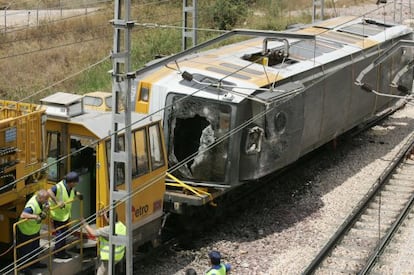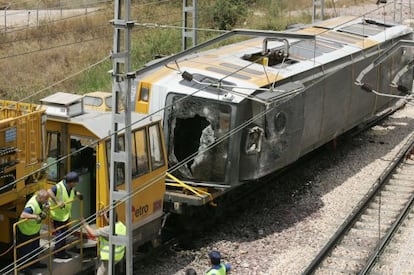Forty-three dead, six years, zero culprits
Victims of the 2006 Valencia subway accident are demanding that the inquiry be reopened

Six years have passed but the feelings of rage and powerlessness have not diminished. "We will not tire until we discover the truth," says Beatriz Garrote, spokeswoman for the Association of the July 3 Metro Victims. On the third day of every month since July 2006, they have observed five minutes of silence in memory of the 43 passengers who died and the 47 who were injured in what was the worst subway train accident in Spanish history. They have never understood how, given the number of victims involved, the inquiry into the incident closed - following a sham of a parliamentary investigation committee, the shelving of the criminal investigation, and no officials found to bear any responsibility.
After years of institutional neglect - former Valencia regional premier Francisco Camps never met with the association - and social invisibility, the broadcast on April 28 of an edition of the investigation series Salvados on La Sexta, which presenter Jordi Évole dedicated to the case, has catapulted it back into national consciousness. The social networks have done the rest.
The case has remained alive through the determination of the victims association and the support of a few media organizations and social groups. But the years of silence have been hard, Garrote admits. Now, however, they are hopeful. Within a few days of posting a petition on the internet platform change.org demanding regional premier Alberto Fabra begin a "truthful investigation" into the accident, they had already received 70,000 signatures, while a demonstration in Valencia on Friday was attended by thousands of people.
A TV show has catapulted the case back into national consciousness
Remembering the tragedy and what happened afterwards remains painful. It was just after 1pm on July 3, 2006 when a train traveling along Line 1 of the Valencia metro system - the most outdated and in need of repair on the network - derailed on a curve between the Plaza España and Jesús stations in the city center. Labor unions from the FGV regional railway, the public company that operates city metro services, had already warned of the dangers of this underground stretch of track.
At the time, Valencia, a region that was and still is governed by the Popular Party (PP) with an absolute majority, was about to hold the Americas Cup yachting race and host a papal visit. The accident occurred just five days before the arrival of Pope Benedict XVI and the regional government was worried it might have been caused by a terrorist attack. Once the initial confusion was over, the theory that gathered strength was excessive speed. The train headed into the corner at 80 km/h when it should have been slowed by a simple 3,000-euro light. The driver died in the accident and with him, the key testimony as to what happened.
The emergency services arrived to find a horrific scene. When the call came in, one of the firemen remembered thinking that a derailment with possible injuries didn't require such a large deployment of personnel. But afterwards he understood: one overturned carriage, another with hardly any visible damage and a track strewn with mangled bodies. "We encountered a field of corpses," he told EL PAÍS. "Almost all of the dead were outside the carriage."

After that the FGV and the regional government were fully employed reducing the incident to an act of chance, attributable to human error. Within hours the government had announced an advance of 60,000 euros to compensate the injured and the relatives of those who had died. Between July and October, Juan Cotino, then one of Camps' ministers and now speaker of the Valencian parliament, visited relatives of the victims in Torrent, the area where many of the dead came from, to afford support and, in a veiled way, offer them jobs and discover if they were thinking of taking legal action against FGV, according to several of the families affected.
The parliamentary investigation committee that the PP reluctantly agreed to hold ended up being one of the briefest in Spain's democratic history. It lasted not months, nor weeks, but merely days, and the PP made the most of its majority to veto appearances requested by opposition groups. The judicial hearing focused on the excessive speed of the train and was finally shelved without anyone being found criminally responsible.
We encountered a field of corpses. All the dead were outside the carriage"
Alberto Fabra met with the victims association after taking office in 2011, but no new action was taken. After that, the veil of silence fell once again.
Valencia's heavy return to Earth after the boom-time years marked by international events has opened a lot of people's eyes, Garrote believes. In the last year, the fact that the FGV hired consultancy firm HM&Sanchis to prepare the testimonies of the experts who appeared at the parliamentary commission; the alleged offers of employment that Cotino gave to victims' relatives, as well as unknown or unnoticed details about the accident, have all come to light. The incident that Camps and the PP thought to have been buried is most certainly not.
Garrote admits it will be difficult to reopen the criminal case, but she believes the Valencian government owes a political and moral debt to the victims and their families. "What do we have to say to Fabra? Whoever has the ability to give [the government] back its dignity, make the most of it," she says.
Tu suscripción se está usando en otro dispositivo
¿Quieres añadir otro usuario a tu suscripción?
Si continúas leyendo en este dispositivo, no se podrá leer en el otro.
FlechaTu suscripción se está usando en otro dispositivo y solo puedes acceder a EL PAÍS desde un dispositivo a la vez.
Si quieres compartir tu cuenta, cambia tu suscripción a la modalidad Premium, así podrás añadir otro usuario. Cada uno accederá con su propia cuenta de email, lo que os permitirá personalizar vuestra experiencia en EL PAÍS.
En el caso de no saber quién está usando tu cuenta, te recomendamos cambiar tu contraseña aquí.
Si decides continuar compartiendo tu cuenta, este mensaje se mostrará en tu dispositivo y en el de la otra persona que está usando tu cuenta de forma indefinida, afectando a tu experiencia de lectura. Puedes consultar aquí los términos y condiciones de la suscripción digital.









































